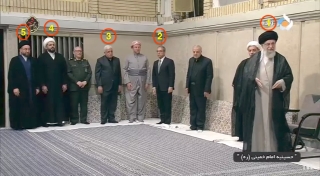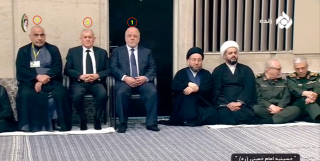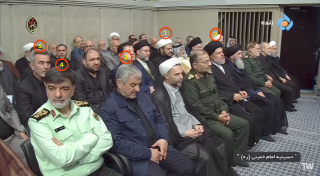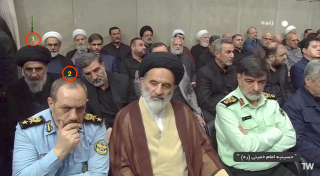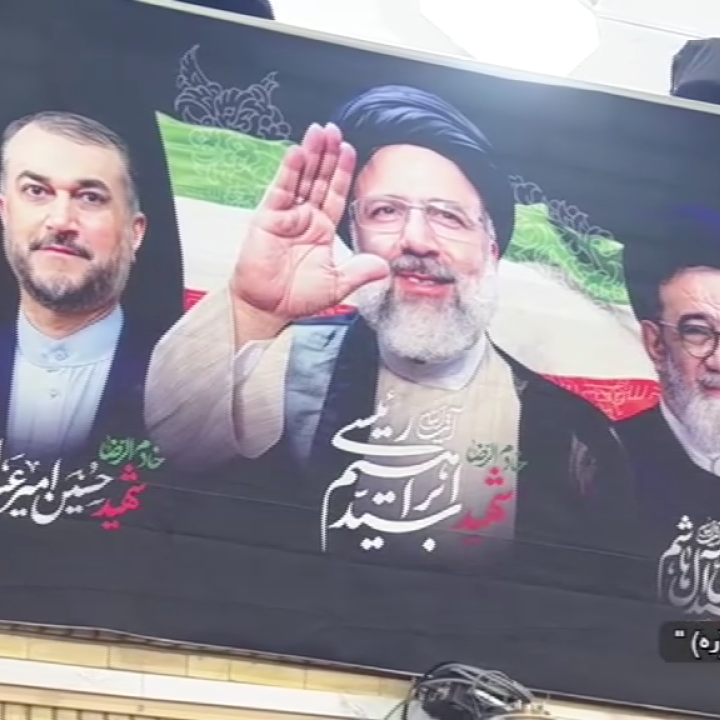
Where Iraqis Landed in the Supreme Leader's Seating Plan

A ceremony held by Khamenei's office gave some clues about the pecking order of the Iraqi "resistance," with political players at the forefront and militia fighters and propagandists in the second tier.
On May 25, the office of Iranian Supreme Leader Ali Khamenei held a commemoration ceremony to honor the late president Ebrahim Raisi, who died in a helicopter crash days earlier. Held in Tehran, the event was attended by many Iraqi officials and militia figures, and their assigned seating positions offered an interesting glimpse into how the Iranian regime views them.
Two departments within Khamenei's office are responsible for these arrangements: the international relations department and the security department, the latter known as Sepah-e Hefazat-e Vali-e Amr (Protection of the Supreme Leader Corps). On the stage and next to Khamenei, they placed several Iraqi officials (see Figures 1 and 2):
- President Abdul Latif Rashid
- Judge Faeq Zaidan, head of Iraq's Supreme Judicial Council
Figure 2: More Iraqi attendees at the May 25 Tehran event: 1. Haider al-Abadi, 2. Abdul Latif Rashid, 3. Adil Abdulmahdi. - Faleh al-Fayyad, a U.S.-designated human rights abuser and head of the Popular Mobilization Forces (PMF)
- Qais al-Khazali, the U.S.-designated terrorist leader of Asaib Ahl al-Haq (AAH)
- Ammar al-Hakim, leader of the Hikma movement
- Haider al-Abadi, former prime minister
- Adil Abdulmahdi, former prime minister
The fact that Khazali was given a place next to the Supreme Leader and top-level Iraqi officials for the first time indicates that the Iranian regime views him as a highly influential figure in Baghdad, a status he obtained due to his role in the Coordination Framework, Iraq's main Shia militia-linked leadership coalition. Zaidan's presence is also significant: he and Raisi were both ambitious supreme court judges who worked closely together, and Raisi appears to have been a model for Zaidan's political ambitions.
Other Iraqi figures were seated in aVIP section (Figures 3 and 4) with regime guests that included Brig. Gen. Aziz Nasirzadeh, deputy chief of staff of Iran's armed forces; Brig. Gen. Ahmad Reza Radan, head of Iran's Law Enforcement Command; and Maj. Gen. Mohammad Ali Jafari, former commander of the Islamic Revolutionary Guard Corps (IRGC). The Iraqis seated in this area included:
- Akram al-Kaabi, the U.S.-designated terrorist leader of Harakat Hezbollah al-Nujaba
- Muhammad al-Tabatabai, deputy leader of AAH
- Abdal-Aziz al-Mohammadawi (aka Abu Fadak), the U.S.-designated terrorist who serves as PMF chief of staff
- Hamid al-Husseini, head of the Iraqi Radio and Television Union, a subsidiary of the U.S.-designated Islamic Radio and Television Union. Husseini is also a member of the Shura Council within the U.S.-designated terrorist organization Kataib Hezbollah.
Figure 5: Hashem al-Haidari, head of the Ahd Allah Islamic Movement, attends Raisi's commemoration ceremony, May 25, 2024.
Abu Fadak's modest placement away from the best seats is a protocol distinction that shows Faleh al-Fayyad retains significant support in Tehran. Other important militia-linked figures were present but also given less prominent places. For instance, Hashem al-Haidari—head of the Ahd Allah Islamic Movement, which is directly funded by Khamenei's office—was seated outside even the secondary VIP section (Figure 5).
With Iraq's next election cycle looming large for October 2025, Iran is seemingly putting politicians and judges at the forefront, at least in public. Yet the less visible but still prestigious placement of "resistance" leaders such as Kaabi, Abu Fadak, and Husseini underlines the vital roles they play in Iran's threat network in Iraq. In particular, Khamenei's office seems to be quietly crediting players like Husseini and Haidari for their critical roles in the "soft war" efforts of the "axis of resistance."

